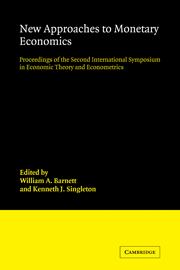 New Approaches to Monetary Economics
New Approaches to Monetary Economics Book contents
- Frontmatter
- Contents
- Editors' introduction
- List of contributors
- Part I Transactions motivated monetary holdings in general equilibrium
- Part II Financial intermediation
- Part III Monetary aggregation theory
- 6 The microeconomic theory of monetary aggregation
- 7 Monetary asset separability tests
- 8 Money demand in open economies: a Divisia application to the U.S. case
- 9 Aggregation of monetary goods: a production model
- 10 Money in the utility function: an empirical implementation
- 11 Comment on papers in Part III
- Part IV Issues on aggregate fluctuations
- Part V Theoretical issues in the foundations of monetary economics and macroeconomics
6 - The microeconomic theory of monetary aggregation
Published online by Cambridge University Press: 04 August 2010
- Frontmatter
- Contents
- Editors' introduction
- List of contributors
- Part I Transactions motivated monetary holdings in general equilibrium
- Part II Financial intermediation
- Part III Monetary aggregation theory
- 6 The microeconomic theory of monetary aggregation
- 7 Monetary asset separability tests
- 8 Money demand in open economies: a Divisia application to the U.S. case
- 9 Aggregation of monetary goods: a production model
- 10 Money in the utility function: an empirical implementation
- 11 Comment on papers in Part III
- Part IV Issues on aggregate fluctuations
- Part V Theoretical issues in the foundations of monetary economics and macroeconomics
Summary
In recent decades there has been a resurgence of interest in index numbers resulting from discoveries that the properties of index numbers can be directly related to the properties of the underlying aggregator functions that they represent. The underlying functions – production functions, utility functions, etc. – are the building blocks of economic theory, and the study of relationships between these functions and index number formulas has been referred to by Samuelson and Swamy (1974) as the economic theory of index numbers.
Introduction
The use of economic index number theory was introduced into monetary theory by Barnett (1980a, 1981a). His merger of economic index number theory with monetary theory was based upon the use of Diewert's approach to producing “superlative” approximations to the exact aggregates from consumer demand theory. As a result, Barnett's approach produces a Diewert-superlative measure of the monetary service flow perceived to be received by consumers from their monetary asset portfolio. However, aggregation and index number theory are highly developed in production theory as well as in consumer demand theory. Substantial literatures exist on aggregation over factor inputs demanded by firms, aggregation over multiple product outputs produced by firms, and aggregation over individual firms and consumers. In addition, substantial literatures exist on exact measurement of value added by firms and of technical change by firms. All of these literatures are potentially relevant to closing a cleared money market in an exact aggregation-theoretic monetary aggregate.
- Type
- Chapter
- Information
- New Approaches to Monetary EconomicsProceedings of the Second International Symposium in Economic Theory and Econometrics, pp. 115 - 168Publisher: Cambridge University PressPrint publication year: 1987
- 37
- Cited by
